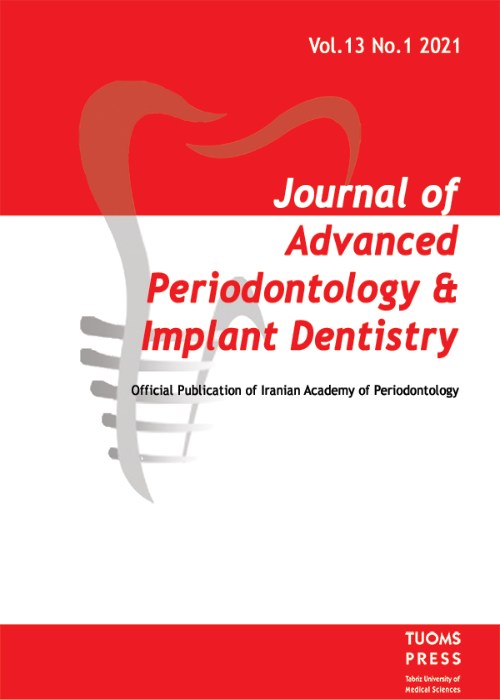فهرست مطالب
Journal of Advanced Periodontology and Implant Dentistry
Volume:6 Issue: 2, Dec 2014
- تاریخ انتشار: 1393/10/18
- تعداد عناوین: 6
-
-
Page 35Background And AimsAlong with conventional periodontal therapy, subginigval application of platelet-rich plasma (PRP) may provide more effective improvements in clinical parameters due to the presence of multiple growth factors. The aim of this double-blind, split-mouth, randomized study was to evaluate the adjunctive use of PRP with scaling and root planing (SRP) in the treatment of chronic periodontitis.Materials And MethodsA total of 87 non-smokers suffering from moderate to severe chronic periodontitis were se-lected. Parameters were probing pocket depth (PPD), clinical attachment level (CAL), plaque index (PI) and modified bleeding index (mBI). After full-mouth SRP the sites were randomly divided into experimental sites receiving subgingival application of autologous PRP and controls treated with placebo gel. Measurements were recorded at baseline, 3 months and 6 months. Paired t-test was used to compare response to treatment between the two sites.ResultsStatistically significant changes in parameters were seen in both groups from baseline to 6 months. Inter-group com-parison revealed significantly more clinical attachment gain for the experimental group (P>0.05). The mean CAL gain was 2.40±0.4 mm for control sites and 2.68±0.5 mm for experimental sites.ConclusionThis study supports the use of PRP during nonsurgical debridement of periodontal pockets measured 6 months after SRP.
-
Page 40Background And AimsA plethora of definitions has been used for periodontitis for epidemiological studies. The aim of this cross-sectional study was to assess the impact of different case definitions on the prevalence of periodontitis and to find the level of agreement among them.Materials And MethodsPeriodontal records of 300 subjects were randomly selected from the database of Oral Health Center, International Medical University. The prevalence of periodontitis was determined using six different case definitions of I, II, III, IV, Va and Vb previously used in various studies. The definition Va proposed by CDC Periodontal Disease Surveillance Workgroup was adopted as the gold standard to calculate sensitivity and specificity.ResultsThere were large variations in the prevalence of periodontitis based on different definitions, ranging from 28% to 76.7%. There was good agreement between definitions III and Vb (0.901) and definitions II and III (0.713). Definition II had the highest agreement with the gold standard (Va) among all the definitions. Excluding definition I, all had a high specificity to the gold standard.ConclusionThe prevalence of periodontitis is greatly influenced by the choice of the case definition. Prevalence rates with definition II could be more accurate if the true prevalence is determined by definition Va
-
Page 47Background And AimsThe purpose of this study was to compare the effects on patients’ discomfort of four different protective methods for donor sites after free gingival graft (FGG) surgery.Materials And MethodsThis study compared the effects of four different covering methods on discomfort (pain, chewing, speaking, appearance) of patients at the donor site. This study included 4 groups: Group A, periodontal dressing (PD); group B, Essix retainer, group C, modified Essix retainer and group D, modified Hawley retainer. A visual analog scale (VAS) was used to measure the experienced discomfort.ResultsThe mean VAS scores for pain were higher in group A compared to those in groups with retainers for both assessments, but there was only statistically significance at T1 (P>0.05). While bleeding was significantly more common in group A than in the other groups at T1 (after one week) and T2 (after two week) (P0.05). The present study showed that speaking and appearance VAS scores in the PD group were lower than those in groups with retainers (P)
-
Page 54Background And AimsThe aim of this study was to assess the opening torque of grooved and non-grooved screws made of shape memory alloys (SMA) for fixation of mandibular fractures.Materials And MethodsIn this in vitro study the opening torques of ten SMA screws with grooves and ten SMA screws without grooves were compared in 20 holes (10 holes for grooved screws and 10 holes for non-grooved screws) placed in the bovine mandible. Statistical significance was set at P < 0.05.ResultsThe mean opening torque was 2.27 ± 0.43 nm for screws in the control group and 2.05 ± 0.45 nm for screws in the grooved group (P < 0.05, P = 0.08).ConclusionThis study revealed that the torque needed for opening the grooved screws was higher in comparison with current fixation screws; however, the difference was not statistically significant
-
Page 60Leukemia is a neoplastic disease with early oral and periodontal manifestations such as ulceration, infection, bleeding and gingival hyperplasia. This paper describes a 39-year-old pregnant woman with a diagnosis of acute myelomonocytic leu-kemia (AML), with gingival enlargement in the upper and lower jaws. A gingival biopsy was performed, followed by a complete blood count and peripheral blood smear. From a histopathological view, infiltration of the neoplastic (myelomo-nocytoblastic) cells was observed and many immature lymphoid cells were revealed by the hematologic tests. The interest-ing clinical finding about this case was the absence of spontaneous bleeding and profuse bleeding on probing. This case is reported to emphasize the leukemia-induced gingival enlargement in pregnancy and the early diagnosis of AML by dentists, which results in immediate treatment and management of the patient.
-
Page 64This article describes the cause of a sinus tract developed four years after implant-supported prosthodontic treatment. The sinus tract and pain appeared to be associated with an accidentally embedded piece of condensation silicone impression material. The residual material was removed by a simple surgical incision. Clinicians should be aware of the odds of this event and take it into consideration whenever there is a similar postoperative problem.


